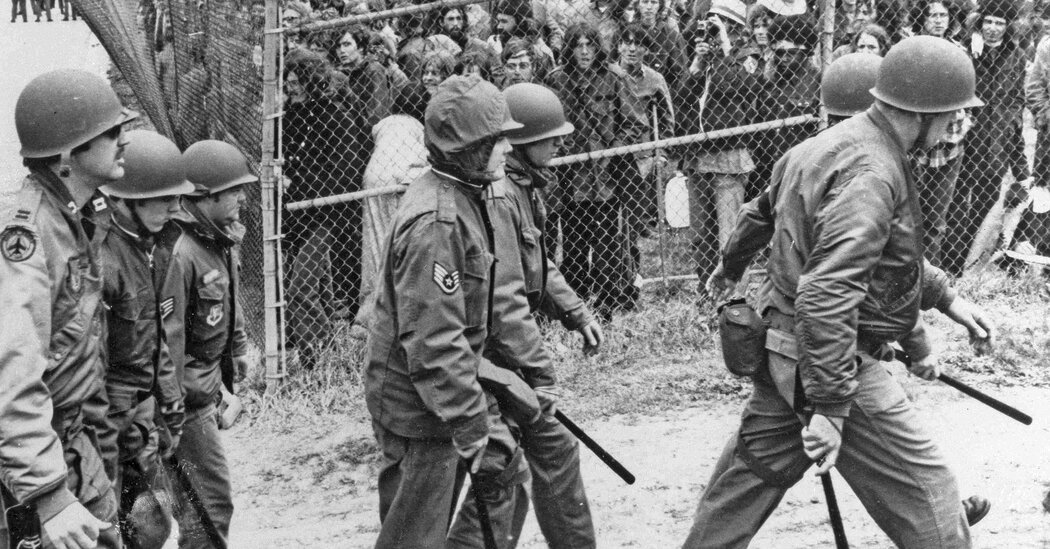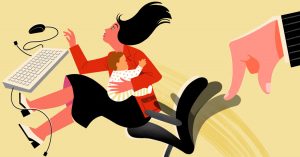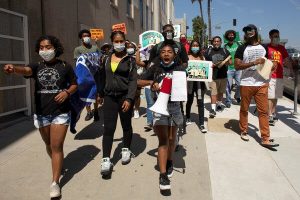In the spring of 1971, Richard Nixon found himself in a situation not unlike President Trump’s. His approval rating was falling — in Mr. Nixon’s case, to a first-term low — just as an energetic social movement was hitting the streets. Like Mr. Trump, Mr. Nixon was tempted to use military force to counter those dissenters. And like the current president, Mr. Nixon and his aides found a way around the Pentagon’s resistance.
The occasion was the most audacious plan yet by the six-year-old movement against the Vietnam War. A group called the Mayday Tribe organized a traffic blockade of Washington under the slogan “If the government won’t stop the war, we’ll stop the government.”
As the Mayday action unfolded on May 3, twin-engine Chinook helicopters roared down by the Washington Monument, disgorging troops from the 82nd Airborne Division, who trotted off to the Capitol and other hot spots. In all, the administration summoned 10,000 soldiers and Marines, turning “the center of the nation’s capital into an armed camp with thousands of troops lining the bridges and principal streets, helicopters whirring overhead and helmeted police charging crowds of civilians with nightsticks and tear gas,” according to a New York Times report. More than 12,000 people were swept up over three days, the largest mass arrest in U.S. history.
John Dean, the Nixon aide who flipped on his boss in the Watergate scandal, wrote recently in The Times: “Never once did I hear anyone in the Nixon White House or Justice Department suggest using United States military forces, or any federal officers outside the military, to quell civil unrest or disorder. Nor have I found any evidence of such activity after the fact, when digging through the historical record.”
Mr. Dean and I were there on Mayday (he was inside the White House; I was on the streets). He has suggested that the troops were called by city officials, not Mr. Nixon, and in any case weren’t used offensively to quell the blockade. I also dug through the historical record, for a new book on those events, and came to quite a different conclusion. What I found in White House tapes, in minutes of planning meetings and in the papers of Mr. Nixon’s aides, including those of his chief of staff, H.R. Haldeman, and his chief domestic adviser, John Ehrlichman, left no doubt that a half century ago, a president under siege resorted to military force and mass arrests for political gain.
The Mayday protest was the finale of an extraordinary season of dissent. After Mr. Nixon expanded the Vietnam War into Laos, hundreds of thousands of protesters arrived in Washington for a variety of events. Among them were Vietnam veterans, “flower children,” self-styled revolutionaries and pacifists. Veterans hurled medals onto the Capitol’s steps. Quakers held pray-ins. A mass march, almost surely the biggest the city had seen, stretched along the National Mall. Then, on the first weekend in May, more than 40,000 people gathered by the Potomac River for the Mayday action.
The antiwar movement had already helped turn public opinion against Mr. Nixon’s conduct of the war. He was determined to deny activists a victory that could cause further political damage. He blasted them in private with rants like “Little bastards are draft dodgers, country-haters or don’t-cares.”(If Mr. Nixon had access to Twitter, his tweets would have been eerily similar to Mr. Trump’s.) He instructed aides to ensure the blockade would fail and, as one put it, didn’t care if it took 100,000 troops, and if they came up short, “someone will be in big trouble.”
Mr. Nixon’s men convened a war council with representatives of the police, the military and the National Guard. Presiding was the deputy attorney general, Richard Kleindienst. Washington didn’t yet have home rule, so the police chief, Jerry V. Wilson, answered to the White House. Mr. Kleindienst and Mr. Ehrlichman batted away objections from Chief Wilson and Army Lt. Gen. Hugh Exton, who questioned Mr. Kleindienst’s demand for 10,000 regular troops, given that thousands of police and guardsmen were already available. They suggested such force might do more to inflame the situation than calm it. Separately, Pentagon officials told Mr. Kleindienst that his plan “to combat dissent,” as they characterized it, might not comport with the rules. They reminded him of the 1878 Posse Comitatus Act, which generally bans active duty troops from law enforcement.
Mr. Kleindienst overrode their concerns with an opinion from the Justice Department’s legal counsel, William Rehnquist, who had been his protégé in their home state, Arizona. Mr. Rehnquist said the act didn’t apply; the president had “inherent constitutional authority” to use troops “to protect the functioning of the government.” (Mr. Rehnquist would be named to the Supreme Court by Mr. Nixon later that year and elevated to chief justice under President Ronald Reagan.)
Mr. Kleindienst faced another obstacle. David Packard, the deputy secretary of defense, pointed out the procedures a president should follow, under the Insurrection Act, in calling forth the military: a formal order that demonstrators disperse and, if they don’t, an executive order to send in troops. Mr. Nixon’s predecessor, Lyndon Johnson, had done this during the riots in Washington in 1968 after the assassination of Martin Luther King Jr. The White House, however, wanted to keep its involvement under wraps. According to Mr. Haldeman’s diary, Mr. Nixon let Mr. Packard know he wanted troops sent without any public presidential action. The White House spread the fake news that city officials had requested the military help.
In contrast, Mr. Trump has been open about his desire to send troops to “dominate” streets in cities with Black Lives Matter protests. After Defense Secretary Mark Esper and the chairman of the Joint Chiefs of Staff, Gen. Mark Milley, stood in the way of using active-duty military, the president dispatched forces from agencies including Customs and Border Protection. In June, those agents cleared peaceful demonstrators from Lafayette Square outside the White House for the president’s now-famous photo op in front of a church. In Portland, Ore., they used tear gas and other riot tools to disperse largely peaceful protesters outside the federal courthouse.
During the 1971 Mayday action, as 12,000 people tried to snarl rush-hour traffic with nonviolent civil disobedience, a majority of the regular troops fended off protesters at bridges and federal buildings, or guarded large groups of detained protesters. Most soldiers didn’t confront demonstrators directly, but their presence and hardware bolstered the authoritarian tactics and escalated tensions. A police dragnet swept up 7,000 people that Monday, including many young people just walking on the streets wearing hippie-style clothing, and took in more than 5,000 other demonstrators over the next two days. My research confirmed that Mr. Nixon gave the order to make the mass arrests. He made it clear later to a group of conservative members of Congress: “The point is, I had the responsibility,” he told them. “I approved this plan.”
As criticism mounted that the dragnet was unconstitutional (courts ultimately agreed, awarding detainees millions in damages), Mr. Nixon’s involvement was suspected. The White House denied it. Aides instructed the police chief, Mr. Wilson, to take the heat. “I wish to emphasize the fact that I made all tactical decisions relating to the recent disorders,” he said in a public statement. “I took these steps because I felt they were necessary to protect the safety of law-abiding citizens and to maintain order in the city.” The tapes show Mr. Nixon’s men were delighted.
“Wilson went to the mat today,” Mr. Ehrlichman confirmed to Mr. Nixon. “Good for him!” the president said. Mr. Ehrlichman added, “We programmed him to do this this morning, and he did better than you could possibly have programmed.” He went on: “He has never let us down yet.”
No military leader expressed second thoughts in the weeks after Mayday.
But in June, after General Milley accompanied Mr. Trump to Lafayette Square wearing combat fatigues as protesters were dispersed by federal agents and police, he said he regretted taking part.
“We must hold dear the principle of an apolitical military that is so deeply rooted in the very essence of our republic,” General Milley told graduates of National Defense University. “And this is not easy. It takes time and work and effort, but it may be the most important thing each and every one of us does every single day. And my second piece of advice is very simple: Embrace the Constitution.”
Lawrence Roberts, a former editor at ProPublica and The Washington Post, is the author of “Mayday 1971: A White House at War, a Revolt in the Streets, and the Untold History of America’s Biggest Mass Arrest.”
The Times is committed to publishing a diversity of letters to the editor. We’d like to hear what you think about this or any of our articles. Here are some tips. And here’s our email: [email protected].
Follow The New York Times Opinion section on Facebook, Twitter (@NYTopinion) and Instagram.



















